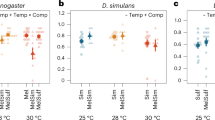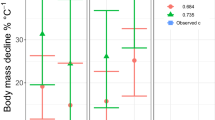Abstract
Metazoans must develop from zygotes to feeding organisms. In doing so, developing offspring consume up to 60% of the energy provided by their parent. The cost of development depends on two rates: metabolic rate, which determines the rate that energy is used; and developmental rate, which determines the length of the developmental period. Both development and metabolism are highly temperature-dependent such that developmental costs should be sensitive to the local thermal environment. Here, we develop, parameterize and test developmental cost theory, a physiologically explicit theory that reveals that ectotherms have narrow thermal windows in which developmental costs are minimized (Topt). Our developmental cost theory-derived estimates of Topt predict the natural thermal environment of 71 species across seven phyla remarkably well (R2 ~0.83). Developmental cost theory predicts that costs of development are much more sensitive to small changes in temperature than classic measures such as survival. Warming-driven changes to developmental costs are predicted to strongly affect population replenishment and developmental cost theory provides a mechanistic foundation for determining which species are most at risk. Developmental cost theory predicts that tropical aquatic species and most non-nesting terrestrial species are likely to incur the greatest increase in developmental costs from future warming.
This is a preview of subscription content, access via your institution
Access options
Access Nature and 54 other Nature Portfolio journals
Get Nature+, our best-value online-access subscription
$29.99 / 30 days
cancel any time
Subscribe to this journal
Receive 12 digital issues and online access to articles
$119.00 per year
only $9.92 per issue
Buy this article
- Purchase on Springer Link
- Instant access to full article PDF
Prices may be subject to local taxes which are calculated during checkout




Similar content being viewed by others
Data availability
The data used in these meta-analyses are available from Dryad: https://doi.org/10.5061/dryad.zw3r2284x.
References
Mueller, C. A., Joss, J. M. P. & Seymour, R. S. The energy cost of embryonic development in fishes and amphibians, with emphasis on new data from the Australian lungfish, Neoceratodus forsteri. J. Comp. Physiol. B 181, 43–52 (2011).
Bennett, C. E. & Marshall, D. J. The relative energetic costs of the larval period, larval swimming and metamorphosis for the ascidian Diplosoma listerianum. Mar. Freshwat. Behav. Physiol. 38, 21–29 (2005).
Pettersen, A. K., White, C. R., Bryson-Richardson, R. J. & Marshall, D. J. Linking life-history theory and metabolic theory explains the offspring size-temperature relationship. Ecol. Lett. 22, 518–526 (2019).
Kamler, E. Early Life History of Fish—An Energetics Approach, Vol. 4 (Chapman and Hall, 1992).
Kamler, E. Parent–egg–progeny relationships in teleost fishes: an energetics perspective. Rev. Fish Biol. Fish. 15, 399–421 (2005).
Zuo, W. Y., Moses, M. E., West, G. B., Hou, C. & Brown, J. H. A general model for effects of temperature on ectotherm ontogenetic growth and development. Proc. R. Soc. B 279, 1840–1846 (2012).
Gillooly, J. F., Charnov, E. L., West, G. B., Savage, V. M. & Brown, J. H. Effects of size and temperature on developmental time. Nature 417, 70–73 (2002).
Pinsky, M. L., Eikeset, A. M., McCauley, D. J., Payne, J. L. & Sunday, J. M. Greater vulnerability to warming of marine versus terrestrial ectotherms. Nature 569, 108–111 (2019).
Pechenik, J. A. Larval experience and latent effects—metamorphosis is not a new beginning. Integr. Comp. Biol. 46, 323–333 (2006).
Marshall, D. J., Pettersen, A. K. & Cameron, H. A global synthesis of offspring size variation, its eco-evolutionary causes and consequences. Funct. Ecol. 32, 1436–1446 (2018).
Vance, R. R. On reproductive strategies in marine benthic invertebrates. Am. Nat. 107, 339–352 (1973).
Shine, R. Manipulative mothers and selective forces: the effects of reproduction on thermoregulation in reptiles. Herpetologica 68, 289–298 (2012).
Goller, M., Goller, F. & French, S. S. A heterogeneous thermal environment enables remarkable behavioral thermoregulation in Uta stansburiana. Ecol. Evol. 4, 3319–3329 (2014).
Steele, J. H. A comparison of terrestrial and marine ecological systems. Nature 313, 355–358 (1985).
Melampy, R. M. & Willis, E. R. Respiratory metabolism during larval and pupal development of the female honeybee (Apis mellifica L.). Physiol. Zool. 12, 302–311 (1939).
Seebacher, F., White, C. R. & Franklin, C. E. Physiological plasticity increases resilience of ectothermic animals to climate change. Nat. Clim. Change 5, 61–66 (2014).
Berrigan, D. & Partridge, L. Influence of temperature and activity on the metabolic rate of adult Drosophila melanogaster. Comp. Biochem. Physiol. A 118, 1301–1307 (1997).
Alton, L. A., Condon, C., White, C. R. & Angilletta, M. J. Jr Colder environments did not select for a faster metabolism during experimental evolution of Drosophila melanogaster. Evolution 71, 145–152 (2017).
Pinheiro, J., Bates, D., DebRoy, S., Sarkar, D. & R Core Team. nlme: Linear and Nonlinear Mixed Effects Models. R package version 3.1-101 (2011).
Nakagawa, S. & Lagisz, M. Visualizing unbiased and biased unweighted meta-analyses. J. Evol. Biol. 29, 1914–1916 (2016).
Orme, D. The caper Package: Comparative Analysis of Phylogenetics and Evolution in R. R package version 5 (2013).
Michonneau, F., Brown, J. W. & Winter, D. J. rot1: an R package to interact with the Open Tree of Life data. Methods Ecol. Evol. 7, 1476–1481 (2016).
Hinchliff, C. E. et al. Synthesis of phylogeny and taxonomy into a comprehensive tree of life. Proc. Natl Acad. Sci. USA 112, 12764–12769 (2015).
Moher, D., Liberati, A., Tetzlaff, J., Altman, D. G. & The, P. G. Preferred reporting items for systematic reviews and meta-analyses: the PRISMA statement. PLoS Med. 6, e1000097 (2009).
Pagel, M. Inferring the historical patterns of biological evolution. Nature 401, 877–884 (1999).
Hadfield, J. D. & Nakagawa, S. General quantitative genetic methods for comparative biology: phylogenies, taxonomies and multi-trait models for continuous and categorical characters. J. Evol. Biol. 23, 494–508 (2010).
Quinn, G. P. & Keough, M. J. Experimental Design and Data Analysis for Biologists (Cambridge Univ. Press, 2002).
Acknowledgements
We thank B. Comerford, M. Parascandalo and L. Morris for assistance. This work was supported by funding to the Centre for Geometric Biology, Monash University.
Author information
Authors and Affiliations
Contributions
D.J.M. conceived the study, collected and analysed the data and wrote the first draft. M.B. developed the mathematical theory. D.J.M. and A.K.P. collected the data. D.J.M. and C.R.W. analysed the data. All authors contributed to subsequent drafts.
Corresponding author
Ethics declarations
Competing interests
The authors declare no competing interests.
Additional information
Publisher’s note Springer Nature remains neutral with regard to jurisdictional claims in published maps and institutional affiliations.
Supplementary information
Supplementary Information
Supplementary text 1–3, Tables 1–4, Figs. 1–3 and references.
Rights and permissions
About this article
Cite this article
Marshall, D.J., Pettersen, A.K., Bode, M. et al. Developmental cost theory predicts thermal environment and vulnerability to global warming. Nat Ecol Evol 4, 406–411 (2020). https://doi.org/10.1038/s41559-020-1114-9
Received:
Accepted:
Published:
Issue Date:
DOI: https://doi.org/10.1038/s41559-020-1114-9
This article is cited by
-
Heritability and developmental plasticity of growth in an oviparous lizard
Heredity (2024)
-
Impact of developmental temperatures on thermal plasticity and repeatability of metabolic rate
Evolutionary Ecology (2022)
-
Larval thermal conditioning does not improve post-settlement thermal tolerance in the dominant reef-building coral, Montipora capitata
Coral Reefs (2022)
-
Effects of developmental environment on animal personality in a tropical skink
Behavioral Ecology and Sociobiology (2022)
-
The contribution of insects to global forest deadwood decomposition
Nature (2021)



